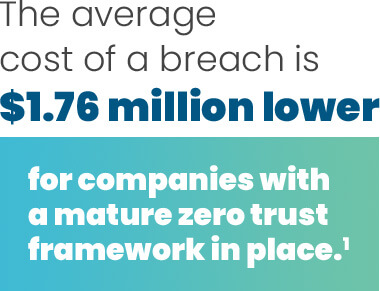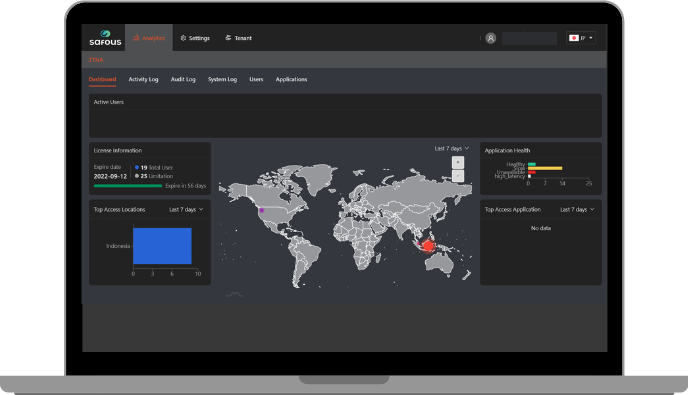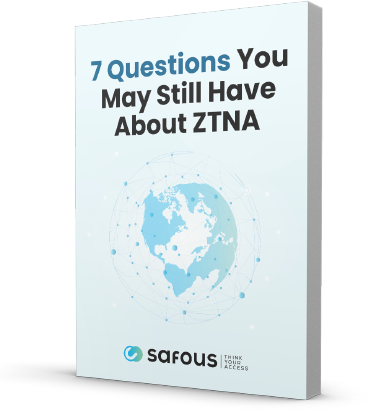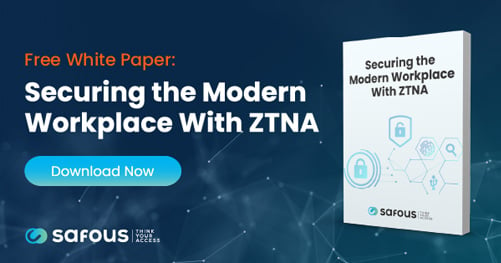The Complete Guide To Securing Your Remote Workforce With Zero Trust and ZTA
The new world of work is here, and businesses are settling into long-term hybrid and remote work arrangements. But while flexible work models boast many benefits for employers and employees alike, they aren’t without their share of complications.
- Remote Work Cybersecurity Threats and Trends
- What Is Zero Trust?
- What Is Zero Trust Access (ZTA)?
- What is Zero Trust Network Access (ZTNA)?
- How Does ZTA Secure the Remote Workforce?
- How Do Remote Browser Isolation (RBI) and ZTNA Work Together?
- ZTNA vs. Other Cybersecurity Solutions
- Benefits of Zero Trust and ZTA
- Keep Your Network Safer Than Ever With Safous
 Remote work has had a direct impact on the cost of data breaches. Case in point: organizations without a zero trust security model in place spend an average of $1 million more on data breach costs than those with zero trust deployed.1 Additionally, 74% of businesses have experienced a breach tracing back to a remote device.2 If companies intend to avoid the costly risks created by remote work, they must take extra precautions to secure their work-from-anywhere employees.
Remote work has had a direct impact on the cost of data breaches. Case in point: organizations without a zero trust security model in place spend an average of $1 million more on data breach costs than those with zero trust deployed.1 Additionally, 74% of businesses have experienced a breach tracing back to a remote device.2 If companies intend to avoid the costly risks created by remote work, they must take extra precautions to secure their work-from-anywhere employees.
That’s where zero trust comes in. From private corporations to the U.S. federal government, zero trust is quickly becoming the gold standard for secure remote network access. And it’s no wonder why: the average cost of a breach is $1.76 million lower for companies with a mature zero trust framework in place.1
Zero trust secures modern work environments with powerful authentication methods, network segmentation, least access policies, and more, allowing businesses to support remote workers without compromising the corporate network. Let’s explore why business leaders are turning to zero trust as the cybersecurity solution that surpasses all others.
Remote Work Cybersecurity Threats and Trends
Despite the many benefits of hybrid and remote work models, securing these flexible environments has proven to be a challenge for businesses of all sizes. Companies that support remote workforces are now prime targets for cyber criminals, thanks to the expanded attack surface and other vulnerabilities created by adding more endpoints to the corporate network.
Here are the most common cyber threats modern businesses face today:
The ever-changing cybersecurity landscape has also given rise to innovative solutions that help combat the threats targeting remote work environments. A few key cybersecurity trends to watch out for include:
Want to keep up with the latest in cybersecurity news, trends, and thought leadership?
What Is Zero Trust?
The concept of zero trust security has existed for more than a decade, but it didn’t start gaining traction until the pandemic pushed organizations into adopting hybrid and remote work environments as the new normal. 76% of businesses are currently implementing zero trust,6 so it’s clear this security model isn’t going anywhere. Here’s why:
Zero Trust Strengthens Remote Work Security
The increased use of home WiFi networks and bring-your-own-device (BYOD) policies expose corporate networks to countless more unsecured endpoints that legacy cybersecurity solutions are unable to protect. Zero trust boosts remote work security by preventing all network traffic requests until users are verified by identity attributes, eliminating the need for traditional endpoint protection.
Zero Trust Defends Against Sophisticated Cyber Attacks
Hackers are now using artificial intelligence (AI), machine learning, and other advanced technologies to launch increasingly sophisticated attacks, so stricter security measures are needed to defend against these rapidly evolving threats. Zero trust defends against increasingly sophisticated cyber attacks by enforcing network access based on the identity attributes of each requesting user and releasing only the resources necessary to fulfill the request.
Zero Trust Safeguards Cloud Applications
Businesses have very little control over the security of third-party cloud applications their day-to-day operations depend on. Zero trust categorizes cloud-based assets so that security and access policies can be aligned across your entire network – no matter where your cloud applications are located.
What Is Zero Trust Access (ZTA)?
Remote and hybrid work arrangements often mean businesses need to secure a large number of endpoints. ZTA enables you to control not only who, but which devices have access to your network.
To ensure security, ZTA uses:
Businesses can grant access to a user based on their role (employee versus guest, for example) and the policy-based rights granted to that role.
Endpoint management control and visibility is essential in today's business environment. Connected devices don't just include smartphones and laptops that require usernames and passwords for identity verification. Businesses may have printers, door access systems, and other "headless" IoT devices that should only be granted sufficient access to perform a specific function - without creating an additional layer of vulnerability on the network as a result of unnecessary permissions. ZTA ensures these devices are granted role-based access in a similar way that it's granted to human users.
Zero trust network access is an element of ZTA specifically focused on limiting application access.
What Is Zero Trust Network Access (ZTNA)?
ZTNA is the technology that makes implementing a zero trust security model possible. Based on the principle of “never trust, always verify,” ZTNA controls access at the application and data level, protecting corporate networks from threats with more flexibility and efficiency than legacy security solutions.
Those exploring ZTNA may also encounter the term "least privilege access." Least privilege access isolates infected applications and data without disrupting other parts of the network, making it an important part of the ZTNA ecosystem. While ZTNA eliminates threats, least privilege access minimizes and mitigates damage, working together to strengthen an organization’s zero trust security strategy.
ZTNA is a key component of Safous’ ZTA platform. Learn more about ZTNA features here.

How Does ZTNA Secure the Remote Workforce?
As cyber threats targeting remote work environments increase, more companies are opting to leave legacy security tools behind and adopt ZTNA. But how exactly does ZTNA secure remote workforces?
Despite the benefits ZTNA solutions provide to businesses – especially those supporting a remote workforce – some business leaders have dismissed it as a buzzword. There are still many misconceptions surrounding zero trust that contribute to this perception, such as:

How Do Remote Browser Isolation (RBI)
and ZTNA Work Together?
Web browsers are essential for day-to-day business operations, but from a security standpoint, they’re an easy gateway for malware and other cyber threats to infiltrate the corporate network. Most current security tools either:
- detect threats after they’ve entered the network
- require difficult or complex integrations
- block users from accessing necessary websites
IT leaders need a more efficient solution for preventing browser-based attacks. That’s where browser isolation comes in.
Browser isolation technology performs browsing activity outside of the user’s environment, protecting employee devices – and the company network – from threats originating within the browser. There are a few types of browser isolation technologies, but the first choice for most business leaders is remote browser isolation (RBI).
RBI covers all aspects of employee security while browsing by running web-based applications and JavaScript on a cloud server isolated from company network resources. Some benefits of RBI include:
Because web browsers are necessary for operations, RBI has become an important component of ZTNA solutions. While ZTNA prevents cyber attacks directed at the access level, RBI prevents those directed at the browser. Together, these technologies enable businesses to tackle cybersecurity threats on all fronts.
Safous ZTA includes RBI to ensure your network stays protected from threats – even those on the web. Learn more about RBI features here.
ZTNA vs. Other Cybersecurity Solutions
The corporate network has expanded outside the walls of traditional offices as a result of increased remote work and cloud adoption, making ZTNA the optimal solution for securing modern networks. Here’s how ZTNA stacks up against other cybersecurity tools:
An estimated 60% of enterprises will replace their VPNs with ZTNA by 2023,7 and for good reason. VPNs have long been the go-to for enterprise cybersecurity, but cyber attacks targeting VPN vulnerabilities are growing as workforces become more dispersed.
VPNs establish a secure connection for employees over a shared network, allowing access based on implicit trust. Unfortunately, cyber criminals can easily spoof variables like device and location, tricking VPNs into allowing them network access whenever they choose.
With a VPN, connections are made at the network level, so it’s relatively easy for hackers to spread malware and other cyber threats from any connected device. ZTNA manages access at the application level, preventing the spread of malware by shutting down access to other parts of the network.
ZTNA also allows for a faster network connection than VPNs. VPNs route all traffic through the company’s network – even cloud-based applications. If too many employees use the VPN simultaneously, traffic jams can cause the connection to become slow and laggy. ZTNAs allow access to resources in the cloud directly once an employee is authenticated, reducing jams and boosting performance.
Proposed by Gartner in 2019, SASE has also been gaining popularity as a security solution for protecting remote and cloud-based work environments. SASE combines network and security services, enabling businesses to increase security without slowing employee productivity or placing an additional burden on IT teams.
Most SASE solutions are made up of multiple security tools in addition to software-defined wide area networking (SD-WAN), including:
- Secure web gateway (SWG)
- Cloud access security broker (CASB)
- Firewalls
- ZTNA
There isn’t a comprehensive SASE solution currently available that provides all of these features, and not all SASE products include ZTNA functionality. Businesses implementing SASE must invest considerable time and resources into replacing their network infrastructure and may still have to secure a ZTNA solution to get complete protection for their remote workforce.
Outdated, hardware-based security systems worked when companies operated on-premises, but as the workforce expands beyond the walls of traditional offices, these solutions are no longer effective.
Employees are using personal devices and potentially unsecured public and home networks to access the corporate network, widening the attack surface. Legacy security tools were designed to cover traditional network perimeters, but now there are countless endpoints for cyber criminals to exploit that outdated solutions simply can’t protect.
In contrast, ZTNA reduces the attack surface, hiding network resources until access is granted. Verified users then gain access to limited resources based on their needs, while ZTNA re-evaluates access in real time.
The terms ZTNA and software-defined perimeter (SDP) are sometimes used interchangeably; however, SDP is a software-based solution used to enforce zero trust privilege and restrict network access. Cybersecurity solutions built on hardware can’t reap the benefits of SDP, preventing them from fully protecting hybrid and remote workforces.
Benefits of Zero Trust and ZTNA
Zero trust and ZTNA solutions boast several benefits beyond protecting remote work environments. Because the zero trust framework constantly authenticates and verifies all devices and users accessing the network, it offers stronger enterprise network security than any other solution available today. Some benefits of zero trust include:

Interested in implementing zero trust security in your organization? Download our comprehensive white paper today to learn more about how ZTNA delivers fast, secure network access to your employees, regardless of where they’re working or which devices they’re using.
Keep Your Network
Safer Than Ever With Safous
Zero trust and ZTNA solutions have been gaining popularity as the most effective option for tackling cyber attacks – especially those targeting remote and hybrid workforces. As cyber threats get more sophisticated, the need for remote network access control that outsmarts hackers will only continue to grow.
At Safous, we believe in the power of zero trust for securing modern workforces. That’s why we help businesses like yours deliver fast, secure access to company resources with our advanced ZTNA solution. Safous ZTNA is easy to install, provides a high level of control, and lets your employees safely connect to the applications and data they need to work from anywhere.
If you’re ready to get started with zero trust, we have you covered. Request a free demo today to see how Safous ZTNA safeguards your network, supports your remote workforce, and strengthens your zero trust security posture.
Sources
- https://www.ibm.com/security/data-breach
- https://info.lookout.com/rs/051-ESQ-475/images/idg-report-buying-into-mobile-security.pdf
- https://assets.sophos.com/X24WTUEQ/at/4wxp262kpf84t3bxf32wrctm/sophos-state-of-ransomware-healthcare-2022-wp.pdf
- https://services.google.com/fh/files/blogs/google_security_infographic.pdf
- https://www.zdnet.com/article/average-organization-targeted-by-over-700-social-engineering-attacks-each-year-report/
- https://www.microsoft.com/security/blog/2021/07/28/zero-trust-adoption-report-how-does-your-organization-compare/
- https://www.forbes.com/sites/forbestechcouncil/2021/10/01/why-sase-and-ztna-are-even-better-together-when-tightly-integrated/?sh=71604c387e97


